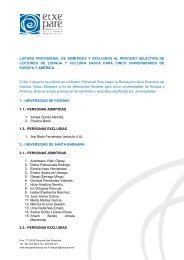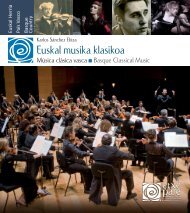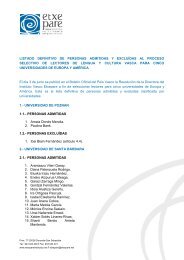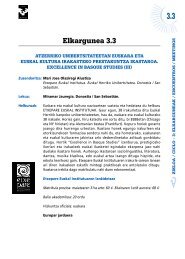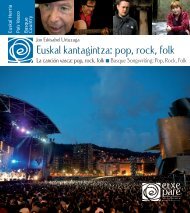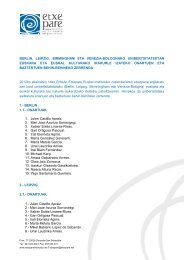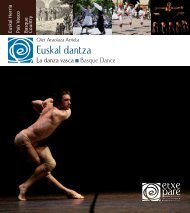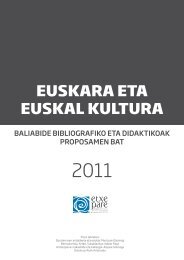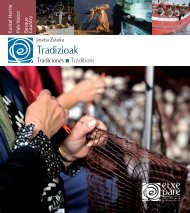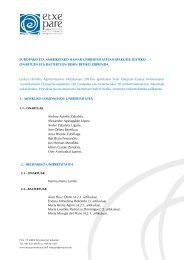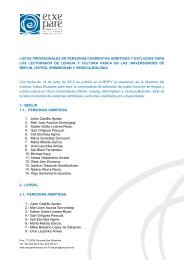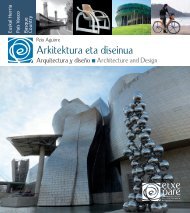XX. mendeko euskal literatura - Etxepare, Euskal Institutua
XX. mendeko euskal literatura - Etxepare, Euskal Institutua
XX. mendeko euskal literatura - Etxepare, Euskal Institutua
Create successful ePaper yourself
Turn your PDF publications into a flip-book with our unique Google optimized e-Paper software.
Pío Baroja (San Sebastián, 1872 - Madrid, 1956) cultivó<br />
preferentemente el género narrativo, pero se<br />
acercó también con frecuencia al ensayo y más ocasionalmente<br />
al teatro, la lírica y la biografía. En sus<br />
novelas reflejó una filosofía impregnada con el profundo<br />
pesimismo de Arthur Schopenhauer, pero que<br />
predicaba en alguna forma una especie de redención<br />
por la acción, en la línea de Friedrich Nietzsche: de<br />
ahí los personajes aventureros y vitalistas que inundan<br />
la mayor parte de sus novelas, pero también los<br />
más escasos abúlicos y desengañados, como el Andrés<br />
Hurtado de El árbol de la ciencia o el Fernando<br />
Ossorio de Camino de perfección (pasión mística),<br />
dos de sus novelas más completas.<br />
Entre los autores pertenecientes a la generación que<br />
vio la luz durante las primeras dos décadas del siglo<br />
<strong>XX</strong> figuran Ignacio Aldecoa (Vitoria-Gasteiz, 1925<br />
- Madrid, 1969), Luis Martín Santos (Larache, Marruecos,<br />
1924 - Vitoria-Gasteiz, 1964), Ramiro Pinilla<br />
(Bilbao, 1923) y Pablo Antoñana (Viana, 1927 - Pamplona,<br />
2009).<br />
La novela Tiempo de silencio de Luis Martín Santos,<br />
publicada en 1962, supuso una revolución en el panorama<br />
novelístico del momento. Esta novela presentó<br />
varias novedades estilísticas como el monólogo<br />
interior, el uso de la segunda persona, el estilo<br />
indirecto libre o el flujo de conciencia, procedimientos<br />
narrativos que venían ensayándose en la novela<br />
europea desde James Joyce pero que eran ajenos al<br />
realismo social al uso de la época. Todo ello contribuyó<br />
a lo que el propio Martín-Santos denominó “realismo<br />
dialéctico”.<br />
Ignacio Aldecoa comenzó a escribir poesía, pero<br />
pronto se decantó por la narrativa, género en el que<br />
destacó especialmente por sus narraciones. Es autor<br />
de varias colecciones de relatos, entre los que figuran<br />
Espera de tercera clase (1955), Vísperas del silencio<br />
(1955), El corazón y otros frutos amargos (1959),<br />
Caballo de pica (1961), Arqueología (1961), Cuaderno<br />
de Godo (1961), Neutral corner (1962) y Pájaros<br />
(1920), San Manuel Bueno, mártir (1930) and Don<br />
Sandalio, jugador de ajedrez (1930).<br />
Pío Baroja (Donostia-San Sebastián, 1872 - Madrid,<br />
1956) preferred the narrative genre, but frequently<br />
wrote essays and very occasionally theatrical works,<br />
poetry and biographies. His novels reveal a philosophy<br />
marked by the deep pessimism of Arthur Schopenhauer,<br />
although he preached to some extent a<br />
kind of redemption through action along the lines<br />
of Friedrich Nietzsche: this is the source of the dynamic<br />
adventurer heroes that pervade most of his<br />
novels, but also of the scarcer apathetic and disillusioned<br />
characters, such as Andrés Hurtado in El árbol<br />
de la ciencia or Fernando Ossorio in Camino de<br />
perfección (pasión mística), two of his best novels.<br />
Amongst the authors belonging to the generation<br />
which emerged in the first two decades of the twentieth<br />
century, one might mention Ignacio Aldecoa<br />
(Vitoria-Gasteiz, 1925 - Madrid, 1969), Luis Martín<br />
Santos (Larache, Morocco, 1924 - Vitoria-Gasteiz,<br />
1964), Ramiro Pinilla (Bilbao, 1923) and Pablo Antoñana<br />
(Viana, 1927 - Pamplona, 2009).<br />
The novel Tiempo de silencio (1962; Time of Silence,<br />
1964) by Luis Martín Santos implied a revolution in<br />
the world of novel-writing at the time. It introduced<br />
several new stylistic elements such as the internal<br />
monologue, the use of the second person, free indirect<br />
speech and stream of consciousness –all narrative<br />
techniques which had been present in European<br />
novels since the time of James Joyce but which were<br />
absent in the fashionable social realism of the era.<br />
All this went to make up what Martín Santos himself<br />
classified as “dialectic realism.”<br />
Ignacio Aldecoa began writing poetry, but soon<br />
decided on narrative, a genre in which he excelled<br />
especially for his narrations. He authored several<br />
collections of short stories, including Espera de tercera<br />
clase (1955), Vísperas del silencio (1955), El<br />
corazón y otros frutos amargos (1959), Caballo de<br />
pica (1961), Arqueología (1961), Cuaderno de Godo<br />
71



